Catalonia in winter Birding Tour, 2020 Trip Report
Number of days: 6
Tour participants: 5
Dates: February 6th to 11th, 2020
All images along the tour by Brian Buffery, Giovanni Grieco and tour leader Carles Oliver.
The tour participants to the tour flew into Barcelona prior the tour started. We met the next morning in their hotel neat the airport for an early morning transfer to the Pyrenees. Temperature was high as a result of several days of high pressures, and temperatures escalating above 20C in the days before the tour started.
Day 1. Once in the Pyrenees, we drove up until 1600 metres high and spent some time in a rocky slope with small cliffs. There, we got good views on Rock Buntings, singing and showing up really well. European Crested Tits were also noted, but we didn’t have any other good bird. From there, the lovely lane brought us throught Mountain forests with small flocks of Mistle Thruses and Common Crossbills. Once the forests end, the lane crosses some alpine meadows show. Due to the long period of high temperatures, the snow was few, and concentrated in a certain slopes. We spent some time scanning, with little success. Only a few Eurasian Griffons were moving in the sky, joined by 1 Common Raven.
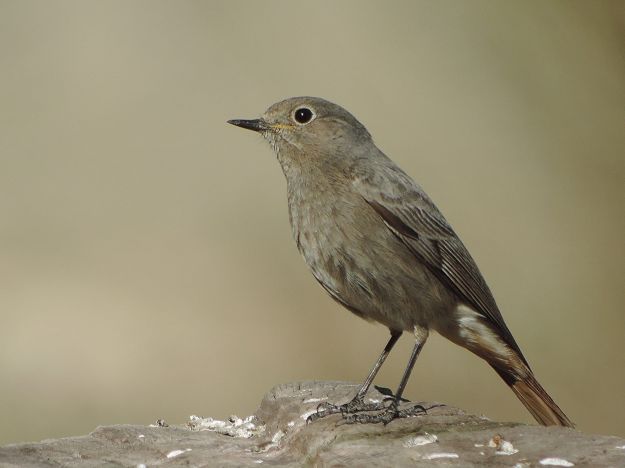
We spent some time scanning the snowed slopes with little luck, and we were about to leave when 3 Snowfinches flew from a spinned slope, really high up in the mountain. Despite teh birds were extremelly far away we decided to spend some time scanning the slope. But nothing. Sowe drove half a mile, and scan again. And now we were more lucky as a nice flock of about 25 Snowfinches showed in the sky, flying from a close slope. The birds we actually doing some short flights to inmediatly reland in the slope, so we got excellent views on the birds walking on the snow, feeding and preening. Unfortunately all birds were a bit far up in the slope, so not really excellent chances for photography. We spent about half an hour waiting for the birds to eventually come down the slope and have closer views. Unfortunately the birds never came really closer.
Happy after the enjoying a species I was not expecting to find, we kept our way and came back to the mountain pass. There, there was a good number of Eurasian Griffons passing by, producing some really good views. Here we also got excellent views on a flock of Alpine Chough flying over, calling, and playing in the sky as only a Chough can do.
Only a pair of minutes after the Chough did its show, a large raptor was seen along with Eurasian Griffons. Moving slowly above the slope, an impressive adult Lammergeier was moving to our position. Everybody connected with the bird of prey way before the bird was close, so everybody enjoyed excellent views on the bird approaching us… The majestic bird just passed over us, the snow reflecting on the underwings so we all enjoyed the details of the axiles, the underwinds and its iconic moustache. The bird was around for some minutes, and we still had a second Lammergeier passing by before we moved to our accommodation for some rest.

After some resting, we still had time to explore a wooded slope in search of some new species. The area was full of Common Crossbills, some of them singing. A lovely Iberian Green Woodpecker was a celebrated spot in the group. The area was full of birds: Eurasian Siskin, Mistle Thrush, Rock Bunting, Short–toed Treecreeper and Crested Tit were also noted. Big flocks of migratory Common Chaffinches were around. We did a number of stops along the lane, and among them 2 Citril Finches passed over our heads, calling. Unfortunately only one tour participant had a view in these birds.
The afternoon was going away and as the night came we moved to a proper spot for the most difficult of the Owls in Europe. We didn’t have to wait long because soon after sunset we had a Tengmalm’s Owl singing quite close to our van! The bird started singing about 80 metres away so we just walked inside the open woodland, trying to find the small owl. We enjoyed a wonderful listening but despite our efforst, we never so this scarce owl!

Day 2. After a good rest, we just started our second day by spending some time in the same lane where we were the last afternoon. Our goal was to have better views on Citril Finches. But that morning we were no lucky about them. After this we spent the rest of the morning in a mountain pass closeby. A huge flock of above 70 Red-billed Choughs was feeding on the greenish slopes that were supposed to be snowed. High temperatures for 15 days in a row right before the arrival of the group had been meltering the snow, and despite our efforts we were uncapable to find any Alpine Accentor, the main goal of the morning.
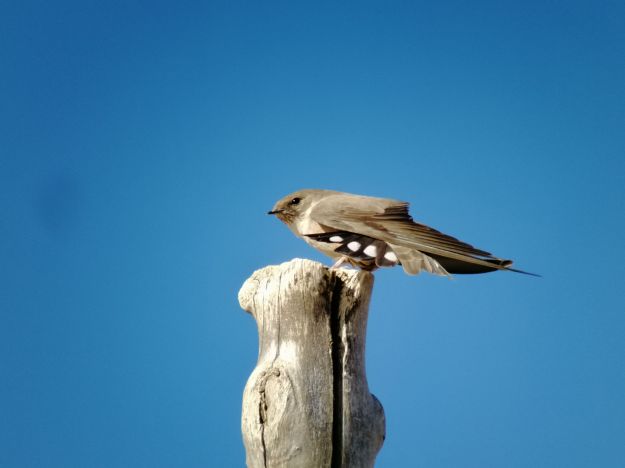
After lunch we drove to the steppes for some afternoon birding. Our first stop was to check some corners looking for one of the most sought-after species in this habitat. Meanwhile, we enjoyed very much to find a large flock of over 150 Eurasian Tree Sparrows. Several other species were recorded around including Eurasian Reed Bunting, Corn Bunting, European Stonechat, Eurasian Skylark, Northern Lapwing, Common Kestrel, Crested Lark, Common Buzzard, Meadow Pipit and several more!

In our second stop we were more lucky, and after some scanning we found 12 Little Bustards in a nearby field. They were hiding in a filed with tall vegetation and we could only count them after a long wait and search of the small neck appearing above the grass. While enjoying them, we got other good birds around including 1 Great White Egret, Grey Heron , Mistle Thrush and Zitting Cisticola.
But a good surprise was to come. In a nearby field, a large flock of over 150 European Golden Plovers was resting. It look like the typcical large premigratory flock. While trying to count the Bustards, Gio was scanning the plovers and he was lucky enough to find out a 1st winter Eurasian Dotterel right in the center of the flock! What a nice spot!!!
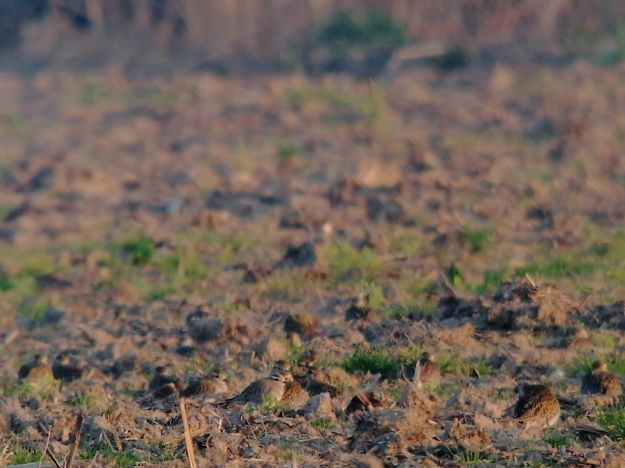
After such a great spot we just moved to a nearby wetland for the last stop of the day. The large fresh water lagoon is placed in the middle of a large plain, and attracks good number os Western Marsh Harriers that roost in the reedbeds. We counted no less than 23 of them! Eurasian Teals, Northern Shovelers, Common Snipes, Reed Buntings, Water Rail, Northern Lapwings, Red–crested Pochards and big numbers of Great Cormorants and Western Jackdaws were all enjoyed, but probably the best birds for most of the tour participants were the Western Swamphens showing in the reedbeds, and noisily calling as the sunset approached. A wonderful end of the day!

Day 3. This day we drove up a long valley, into the a Catalan shire called Pallars, to look for some Pyrenean especialities. Our first stop was in a huge gorge. There, we hope for the most wanted bird for many birdwatchers visting the Pyrenees in winter, the Wallcreeper. During a pair of hours we walked and scouted the rocks all around, hoping for any movement in the cliffs. White–bellied Dippers were singing, very active in the river, and we counted 4 in single corner of the river! Some Eurasian Griffons were also moving in the sky, and didn’t take long until the massive silouhette of 1 Lammergeier appeared from the massive cliffs. Red Kite and Rock Bunting were also enjoyed.
After a long search, we finally found an extremelly distant Wallcreeper in a big, plain rock face. Only 1 tour participant saw the bird, so we all spent a lot of time trying to refind the bird. Some minutes passed away, and nobody was having the Wallcreeper…but suddenly a something moved in the rocks really close to us, inmediatly at the other side of the river: Wallcreeper!
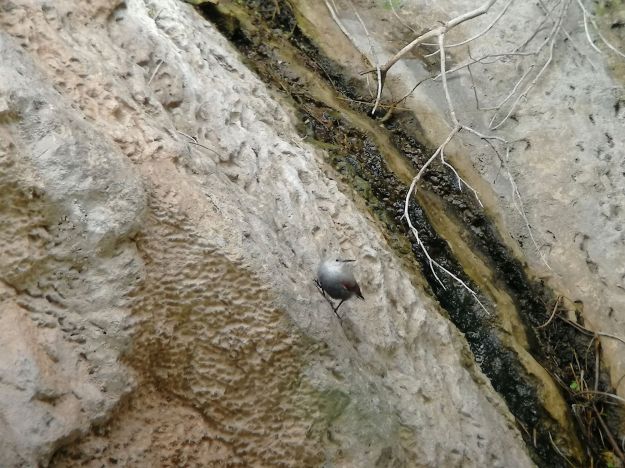
We were having a Wallcreeper right there, and this time everyone in the group found the bird without difficulties! We spent a pair of minutes enjoying of the bird moving in the rock face, beside a huge cavity. As always, it was great moment for anyone in the group!! After taking photos and recording videos we were enjoying the bird until it moved away from the rock face… and then came the typical question, was that the same bird that we were looking for extremely high up, or was it a different one? Who knows…
In this stop we still enjoyed a pair of other good birds before going for a coffee stop as Short–toed Treecreeper and Eurasian Crag Martin showed really well in our way to the car.
After our pic-nic stop, we spent a pair of hours exploring a wooded lane, a wonderful spot for Citril Finches. Again, Common Crossbills were common and active. There were flocks of Eurasian Goldfinches and Common Chaffinches and, while scanning the flocks looking for something different, we enjoyed 2 superb Lammergeiers flying ove us in beautiful light. After a long, long scanning, 2 Citril Finches were seen when driving down the lane so we inmediatly stopped, with the finches calling around and moving in the trees for a some seconds before they moved away as they seemed associated to a huge flock of Common Chaffinches. We scanned over and over the flock but we were uncapable to refind them. Mistle Thrush, Fieldfare and Hawfinch were noted in the while.

The last stop of the day was to look for Eurasian Black Vulture. The Catalan Pyrenees holds a small population of about 50 individuals, concentrated in a pair of valleys but expanding in range and numbers. The whole day had been poor in raptor activity and, when we did arrive to the observation place, the raptor activity was minimal. Still, there were some Eurasian Griffons flying and after some hard scanning we found at least three distant Eurasian Black Vulture circling along with them. Another Lammergeier was also found, by the way. Here we also enjoyed some small birds including Cirl Bunting, Great Spotted Woodpecker and Sardinian Warblers. After this stop we drove back to our accommodation for a good dinner and rest.
Day 4. Early morning start to explore the steppes. After a transfer we did arrive to the dry lands where most of the specialities are to be found. Unfortunately the weather was not good at all, as it was extremelly windy… Windy days can be terrible in the steppes, being quite easy to miss most (or all) the good birds in such a conditions.
But we were confident so our first stop was in a corner were Sandgrouses use to feed in early morning. A first look to the area revealed no activity at all. Only 1 or 2 Calandra Larks were flying, almost no songs in the sky. A distant Red Kite was the most notiable… We moved slowly along the lane, carefully scanning the fields that were hurt by the wind. It took us a good while until we found the first Black–bellied Sandgrouse on the ground. A male. Did an effort to get the scopes out so everybody could enjoy despite the really strong wind. Some minutes later, a small flock of 5 Pin–tailed Sandgrouses moved from a nearby filed, coming closer to us. It took some time to put everybody in the birds as they mild so well even if it was so few grass! Our happiness was complete when we realised that there were also some Black–bellied Sandgrouses on the ground, only few metres away from the Pin–tailed’s!! So, at the end, we had both species together side by side, feeding, preening and enjoying the hard morning weather!


A short drive in the area around provided us with good views on Thekla, Calandra & Sky Larks. Also Little Owl, Iberian Grey Shrike and Red–billed Chough. Due to the wind it was again little movement of raptors in the sky, or that is what it looked like until 4 Golden Eagles appeared in the sky at the same time! Two adults and 2 juveniles playing long time with the wind at short range.

After a coffee stop we still had time to enjoy some good views on Lesser Short–toed Larks before changing the habitat to explore some cliffs nearby.
The short drive to the clay cliffs produced several White Storks, some of them in their nests, Spotless Starlings, and Common Buzzards. Once arrived, we were suprised by a bird moving in the cliff.A Wallcreeper!!! Amazing. It is not normal to see a Wallcreeper so low, and it is even more strange to see it in a clay cliff which is not especially in the middle of the plains! Again everybody enjoyed the bird while moving up. Higher, a Blue Rock Thrush was also really showy. After a pair of minutes enjoying the bird we lost it and spent some time looking for the Black Wheatears living in this spot. After some minutes we had a pair of Black Wheatear moving in the broken slope. Here we also got the firsts Black Redstarts and Common Chiffchaffs of the tour.

After such a wonderful stop, we faced our transfer to Ebro Delta, a pair of hours of driving with several surprises in the way. The area between Lleida Steppes and Ebro Delta is a complex, hilly area crossed by Ebro river. It is good nautral border and a natural corridor that many birds use between the Mediterranean coast and the Pyrenees. The afternoon was sunny and calm and soon we realised that it was a good number of birds of prey migrating. After a pair of stops we had 1 Short-toed Snake Eagle, 1 Black Kite, 1 Northern Goshawk, several Common Buzzards and a few Eurasian Sparrowhawks moving North.
Once in Ebro Delta, we spent the rest of the afternoon in the Northern Bay, where we enjoyed good views on a long list of species. Slender-billed & Audouin’s Gull were the most celebrated but the list also included Whiskered, Caspian & Sandwich Terns, Black-necked Greve, Red-crested Pochard, Kentish Plover, Greenshank, Common Sandpiper, Knot, Eurasian Oystercatcher, Bar-tailed Godwit, Eurasian Curlew, Little Stint, Dunlin, Common Snipe, Common Redshank, big flocks of Greater Flamingoes and Mediterranean Gulls plus ruff views on a female Bluethroat that showed shortly due to the strong wind! After such a great end of the day, we drove to our accommodation for a good rest and plentiful dinner.
Day 5. After enjoying our breakfast we went out to take a fast look to a small pond just by our hotel. There, we had a good surprise as a male Little Bittern moved in the reeds providing good looks. Cetti’s Warbler and Little Egret were also seen there!
But our first serious stop of the day was by the largest fresh water lagoon in the delta, called l’Encanyissada. A pair of stops were enough to catch with some of the most sought-after species. While flocks of Greater Flamingoes were passing over, we enjoyed wonderful views on Western Swamphens. In the lagoon there were flocks of Black–necke Grebes but out attention was focused in the reedbeds. Cetti’s Warbler was showing well in some small plants by the reeds and 2 Water Pipits were seen in a nearby channel along with Green Sandpiper. But all alarms went on when a «tak-tak» came from the reeds. There was a Moustached Warbler just along the edge of the reedbed, calling and moving really low in the brown steems. It didn’t take long until all tour participants were enjoying good views on this shy species!
But the bird spectacled kept going. A flock of 5 Wood Sandpipers flew over right at the same time that 1 White–spotted Bluethroat male called from the reedbed. A bit of scan was required before all tour participants enjoyed excellent views on this bird. The male was actually quite showy and it was calling a pair of times as it was moving along the shore of the channel. A further scan along different channels revealed at least 5 Bluethroats, 2 of them being males in full summer plomage.
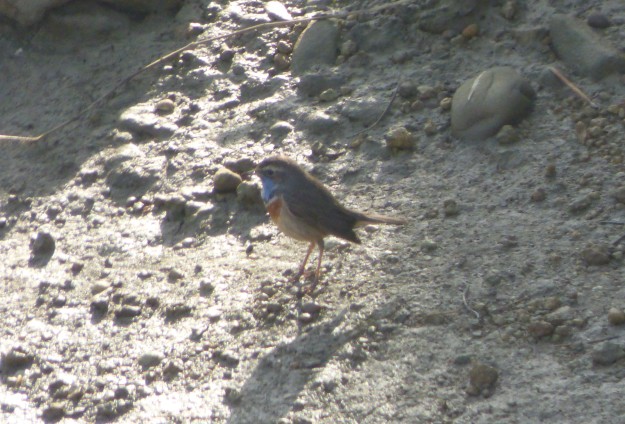
After such a successful stop we decided to move on to explore some salt marshes. The area is an important nesting place for several species, including Audouin’s Gull, and we could see that many of them were already back in the area. At least 80 Audouins’s were there along with Caspian Terns, Grey Plovers, Kentish & Common Ringed Plovers, 100s of Dunlins and at least 7 Little Stints in the middle.

From there we end the morning by exploring a sand bar facing South. This is a good place where to enjoy waders, Terns and Gulls. Several Great Crested Grebes were on the sea, as the sand bar protects a large inner bay. Along with them, 4 Black–throated Divers were fishing and offering great views, but the best was to discover 1 Great Skua resting on the sea, far away but still offering a god view. Closer, flocks of Dunlins & Kentish Plovers were really appreciated by the group, along with the Slender–billed Gulls side by side to Mediterranean Gull. A good way to walk the path of telling them apart. Northern Gannet and Ruddy Turnstone were also enjoyed in this stop.

To enjoy our picnic we went inside a wooded hide. From the hide, it didn’t look like a lot of birds, but we were having a good fun with the nice views on Western Swamphens and Cetti’s Warbler while a Booted Eagle was circling. Suddenly, a Great Spotted Cuckoo crossed the lagoon to stop right beside the hide! Wonderful!! This species of cuckoo arrives really early in the season and by the end of February you can expect some of them moving around, but due to the few time we had in the steppes, I was not expecting to see them at all!

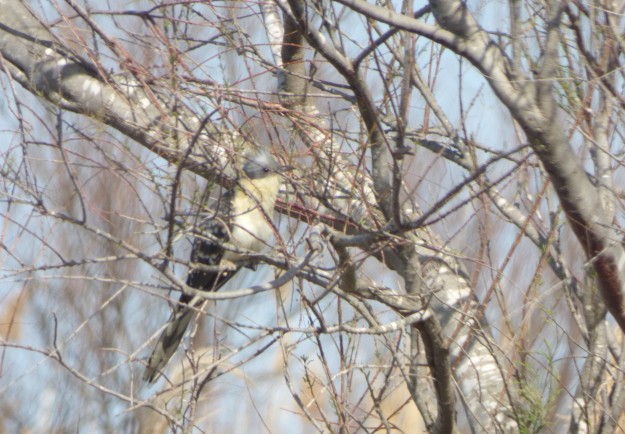
During the afternoon we drove up along a lane to explore a mountainous areas some 30 miles away from Ebro Delta. It is extremelly windy and we had to drive up and down the lane a pair of times before we succeed, but finally we got what we were looking for and 2 Alpine Accentors were seen in the lane, right in front of the car!!! The birds were just feeding by the lane despite the extremelly strong wind but unfortunately they flew off down the slope before we could take any image of them…
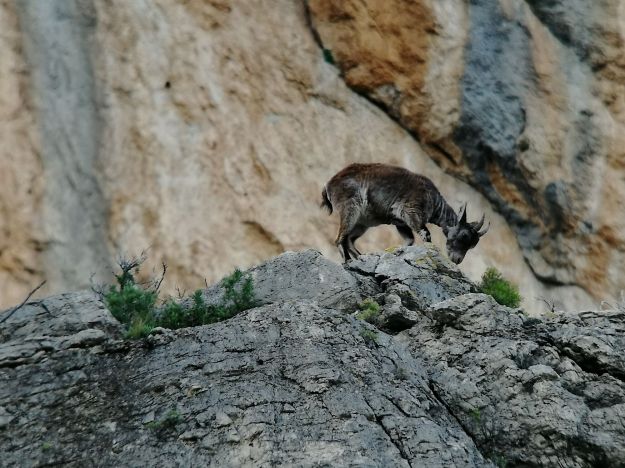
Really happy about this spot, we moved to our final stop. A lovely Mediterranean gorge hosts some really good specialities. Weather conditions were hard so bird activity was really low. Still, we got good views in a female Spanish Ibex and we were about to leave when a call came from high up the cliff and a wonderful male Bonelli’s Eagle came down to inmediatly display over the valley. It called again just when dramatically dived in the sky to come back to the cliffs in a fast movement!!! What a incredible sight to end the day!!!
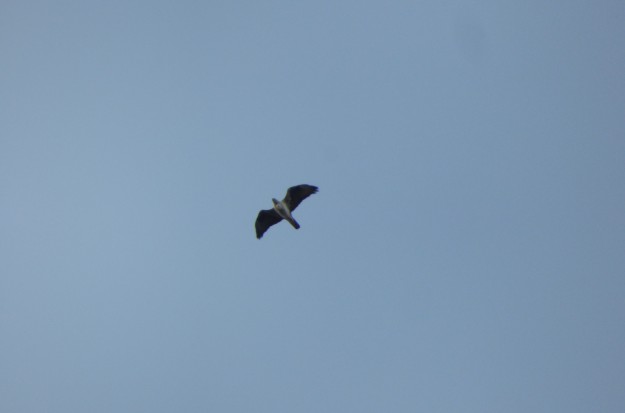
But this was not all. After dinner we just went out to the hotel grounds, were the tour participants enjoyed wonderful vews on 1 Eurasian Scops Owl that is actually nesting in a nest box right there!!!
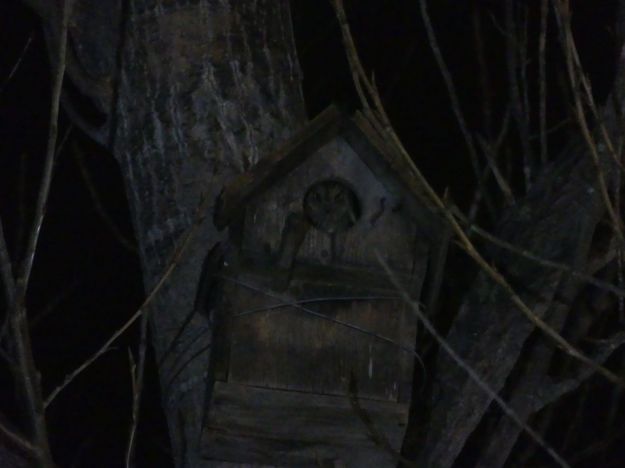
Day 6. Our last day of the tour we spent the morning in the delta. In our first stop we were scouting a large marshy area: big flocks of Black–winged Stilts and Pied Avocets were resting there along with Northern Shovelers, Pintails, Black–tailed Godwits, Common Kingfishers, Shelducks and other goodies. Beyond this spot, the paddy fields around provided good birding and an accurate scan we enjoyed good views on 30 or more Ruffs but also Dunlins, European Golden Plovers, huge flocks of Glossy Ibises, obliging Lesser Short–toed Larks and 1 Peregrine Falcon (probably a calidus race).

It was time to head back to the airport but we still had time for a pair of fast stops around Barcelona. Our picnic stop by the airport reported Water Pipit. The afternoon was rainy and cold but we still tried to get the impressive Red-billed Leiothrix, an alien species living in some well forested areas in Greater Barcelona. By the time we did arrive, the temperature was low but we still managed good views on Firecrest as well as Monk Parakeet, Coal, Long–tailed and European Crested Tits.
Ans this was the end of this wonderful tour to the Pyrenees, despite the really high temperatures!! Already ready for our next adventure, happening very soon.
Do you want to join us?


